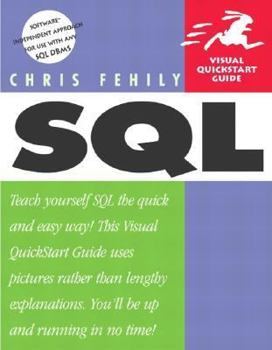SQL
Select Format
Select Condition 
Book Overview
Read this book for free at fehily.com. Perfect for end users, analysts, data scientists, and app developers, this best-selling guide will get you up and running with SQL, the language of databases.... This description may be from another edition of this product.
Format:Paperback
Language:English
ISBN:0321118030
ISBN13:9780321118035
Release Date:January 2002
Publisher:Peachpit Press
Length:424 Pages
Weight:1.45 lbs.
Dimensions:9.0" x 0.8" x 9.0"
Customer Reviews
5 ratings
Perfect SQL classroom text
Published by Thriftbooks.com User , 17 years ago
I am an IT instructor and don't usually have good things to say about computer books. But I couldn't keep quiet about this book which works well in my SQL for SQL Server class and would work just as well in a SQL for MySQL class. Beginning students don't have many choices in SQL books that help them learn the ropes and then don't stop at the definition / syntax level. After several other tries, this one hit the sweet spot of practicality, theory, data, examples, curriculum breadth for a basic SQL course, depth for advanced students, and supplemental information.
Start Your Queries Now!
Published by Thriftbooks.com User , 22 years ago
Excellent book for learning SQL. This little books seems to pack a big punch in everything there is to know about SQL. There are around 200 to 300 sample queries, that start from the basics to nice fancy ones. You will learn about sub setting, functions, grouping, joins, sub queries, set operations, indexes, views, data definition language, and much more. For every topic you will get instructions on how its done in about the five most common SQL implementations.
Extensive Treatment of Nulls
Published by Thriftbooks.com User , 22 years ago
Anyone who uses SQL regularly knows that it's absolutely critical to understand nulls - you can't write SQL programs or interpret results without mastering them. In most of the SQL books that I've read, nulls are mentioned once near the beginning and not given much screen time afterwards - perhaps popping up in an example here and there. This book takes the different (and welcome) approach of weaving the implications of nulls throughout the entire text. In addition to null rudiments, this book addresses crucial issues such as detecting and counting nulls, how nulls give rise to three-value logic (true/false/unknown), when nulls are considered to be duplicates and when they aren't, substituting actual values for nulls and vice versa, how nulls sort, how nulls propagate through computations, which functions ignore nulls and which don't, how nulls affect joins, and how nulls cause problems in subqueries. The book also contains specific tips for Oracle, which (for some reason) considers empty strings to be nulls.
This Book Makes My Job Easier.
Published by Thriftbooks.com User , 22 years ago
There are several "software-independent" SQL books available. I thumbed through a number before landing on this one. I believe I got real lucky. I'm a research analyst at a large medical center. I pull data from various sources using SQL front-ends and stuff data into MS Access for analysis or additional manipulation. I needed an SQL reference for both parts of my job, understanding what I was getting from the hospital systems and writing better SQL in Access or imbeddded SQL in VBA code. This book serves my needs because it is a thorough reference and also because it has plenty of Access examples and tips.I'm also impressed with the layout of the Visual QuickStart Guide. It is very easy to find the information you are after and the bullet points are generally right on target with the details important to the task at hand. I haven't had to read the entire book cover to cover to do some work, and that's the point. When the author does interject himself, his comments are insightful and meaningful. An example, "Although SELECT is powerful, it's not dangerous. You can't use it to add, change or delete data... The dangerous stuff starts in Chapter 9."A great technical reference in a crowded field.
This book helped get me a job
Published by Thriftbooks.com User , 22 years ago
Recently I was "redeployed" - which is the word that my company uses for "laid off if you can't find another job (quick) within the company". I speed-read this book, like cramming for an exam, and applied for the junior database administrator position and got it! Later, the senior DBA told me that I got the job because I knew subtle things about SQL and relational databases that the other candidates didn't know (or got wrong). For example, the difference between a database and a DBMS, why SQL doesn't stand for "Structured Query Language", the difference between server and desktop DBMSes, what the "relational" in "relational database" refers to, the normal forms, and the difference between SQL syntax and semantics. Most of these things were in the first few chapters. Author! Author!





